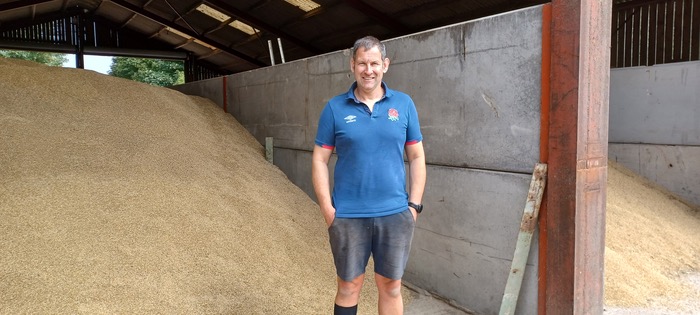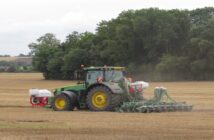Two row winter barley LG Caravelle joined the AHDB RL last year as a contender to match hybrid barley yields, and early harvest reports confirm that it has lived up to its promise.
Despite the challenging season, the variety has performed well on the Yorkshire Wolds. Mark Ullyott of Langtoft Grange Farm near Driffield, is really pleased with his seed crops of LG Caravelle, yielding between 8.5-9.5 t/ha.
“We have grown seed crops of barley for over 10 years, and LG Caravelle must be the best we have seen,” he says.
He grew two fields this year: one following vining peas and the other after potatoes. The crop following the vining peas was drilled on the 28th September at the standard seed rate of 300 seeds/m2. This field was ploughed, pressed & combination drilled.
The field following the potatoes was min-tilled and went in a bit later, on the 23rd October, with a slightly higher seed rate of 350 seeds/m2, to compensate for the later drilling.
Both fields established well and looked pretty good. “We don’t have too much of a black-grass issue, so a pre-emergence application of flufenacet and diflufenican at 0.4 l/ha and some Avadex, pretty much tidied up any weeds,” explains Mr Ullyott.
Disease-wise, the crop stayed clean with a standard fungicide programme, and received 160 kg of Liquid N32/ ha, which was reduced slightly due to the increased fertiliser costs at the time.
“It’s a fairly tall variety, so we used a ‘bottom-shortening’ PGR, chlormequat, but I think the crop would benefit from a ‘top shortener’ as well next time, just to reduce its height that bit more, although it’s important to note the straw strength was good and we didn’t have any lodging or brackling issues.”
“Both fields were ready to harvest by the third week of July, but the wet weather meant the field following the vining peas was ready first on the 31/7 but we had to hold on for another week for the second field, again due to the weather.”
“Despite this, the crop held its own, germ still looked good and bushel weight held up with no sprouting. The straw came off well; all of which goes for home use,” he adds.
“It is always interesting growing a new variety for the first time to see how it performs, and we are very pleased with LG Caravelle and will grow it again. If we could, we would put all of our acreage down to the variety,” says Mr Ullyot.
Recommended List
LG Caravelle joined the 2023/24 Recommended List as the highest yielding two row winter barley.
“We launched the variety not just on the back of its high yields but with a confidence that the variety would deliver across a range of conditions,” says Ron Granger, Limagrain’s arable technical manager.
“The years running up to its recommendation were dry and the variety yielded exceptionally well, however this season has been much wetter but LG Caravelle has upheld its promise of consistency and delivered the yields – and that’s a very valuable attribute on farm.”
Mr Granger explains LG Caravelle’s yield potential is backed up by its specific weight. “Specific weight is important no matter what, and LG Caravelle’s is very high at 71.8 kg/hl. It’s one of the best scores available and is only surpassed by KWS Cassia.”
LG Caravelle’s yield potential is also bolstered by its disease resistance profile, says Ron. “The variety has a 7 for mildew, a 6 for rhynchosporium and a 5 for net blotch,” he explains. “Although there’s no rating on the RL yet, our data indicates the variety scores a 7 against brown rust, which is high against this disease.”
The variety also has resistance to barley yellow mosaic virus, giving it all round disease resistance, he adds. “The culmination of this can be seen in its untreated yield.” “It has a very high untreated yield of 89%, which really gives growers security,” he adds.
Ron feels that growers who’ve been growing hybrids might be interested in returning to two-rows because of LG Caravelle’s performance. “Hybrids account for about 20-25% of the winter barley market but this could change. Plus, we’re currently testing to see if LG Caravelle could be suitable for more than just the feed market.”
“We’re seeing the next step in on-farm varietal security for farmers and these types are proving to be an option on-farm again.”
Fungicide programme:
Esfenvalerate 2.50%, was applied at growth stage 14.
6th May: T1 consisting of Cyprodinil 30.00%, Tribenuron-methyl 14.30%, Metsulfuron-methyl 14.30%, Florasulam 0.25%, Fluroxypyr 10.00%, Trinexapac-ethyl 25.00%, and Folpet.
6th June: T2 consisting of prothioconazole 25.00%, trifloxystrobin 8.80%, prothioconazole 17.50%.




